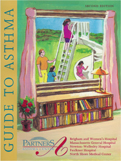Guide to Asthma
Practice Session #4 ("Blowing in the Wind"):
This Spring has been particularly difficult for your asthma. The grass and tree pollens to which you are allergic seem to coat every surface, indoors and outside. Your asthma, more troublesome over the last year or two, has become particularly severe in the last week. You have been coughing up pale yellow sputum, wheezing off and on, and feeling breathless when climbing stairs.
When you went to bed last night everything seemed o.k., but you wake up at 3:00 in the morning with the sense that an elephant is sitting on your chest. It is difficult to pull in air. Every breath seems an effort. You sit up in bed, reach for your quick-relief bronchodilator on the nearby bedside table, and then wait for some relief. You begin to think about what options you have if the inhaler does not help.
You take a lot of medicines on a regular basis for your asthma. You take an inhaled steroid twice daily, theophylline twice daily, a leukotriene blocker in the evening, and prednisone, currently 10 milligrams every other day. You also have an over-the-counter antihistamine and decongestant combination that you are using twice daily.
After 20 minutes you feel only a little bit better. You get out of bed, walk slowly to the kitchen, and make yourself some tea. Even though the doctor specifically mentioned that if you needed help you could call at any time, you are reluctant to call at this hour of the morning. You consider what else you might take for your asthma.
What would you do now?
Discussion:
With so many asthma medicines at your disposal, you may be tempted to take extra doses of some or all of them. Consider carefully. Extra theophylline, a bronchodilator, may help somewhat, but it is risky to take without knowing how much theophylline medicine is already in your bloodstream (the "theophylline level"). Too much theophylline can cause unpleasant side effects (headache, nausea, vomiting, nervousness, and heart pounding). A very high level of theophylline in the blood can even lead to seizures and serious irregular heart rhythms. Best not to take extra doses of theophylline without first discussing this option with your doctor.
Your leukotriene blocker medicine (Accolate® or Singulair®) is taken to prevent asthma symptoms (a preventer medicine). Extra doses would not be effective in treating an asthma attack. Likewise, taking more than the usual dose of your antihistamine/decongestant combination will not help your asthma. It is prescribed for allergy symptoms in your nose and eyes, not as treatment of your asthma.
If you have the long-acting inhaled bronchodilator, salmeterol (Serevent®), in your medicine cabinet, do not use it now for quick relief. It does not work quickly, and its effects last such a long time that it is not appropriate to use it repeatedly in a crisis. Leave it in the medicine cabinet and use it no more than twice a day, as prescribed, even in a crisis.
In an asthma attack your best options are the quick-acting bronchodilator to open the constricted muscles surrounding the breathing tubes and steroids to reduce the swelling (inflammation) in the walls of the tubes.
For this attack you can take more steroids either by increasing the number of puffs of the inhaled steroid that you take each day (take twice as many as before) or by increasing the dose of prednisone. Which approach you choose will depend on how severe this attack is (time to check your peak flow with your peak flow meter!), your past experiences treating similar attacks, and your discussions with your doctor.
Often patients who have taken steroids in tablet form for many years try to avoid increasing the dose in order to avoid more of the serious medication side effects that they cause. However, remember that breathing is a priority! It may be necessary to increase the dose of prednisone to 10 or 20 milligrams every day for a time, then decrease again when feeling better (and when your peak flow has returned back to its usual). Be sure to notify your health care provider if you need to adjust your prednisone dose.
It will take time (at least several hours) for the increased dose of steroids to start to reduce the inflammation of the breathing tubes. In the meantime, you can use your quick-relief bronchodilator more frequently than is usually recommended (that is, more often than the usual limit of four times a day). If necessary, you can take 2-4 puffs every 20 minutes for up to 2 hours and then 2-4 puffs every hour. If you find that you do indeed need the inhaled bronchodilator that often, you are having a very severe attack. You should notify someone, preferably your health care provider, so that you can get help and advice during a bad attack.
While sitting in the kitchen, sipping your tea and waiting for your breathing to return to normal, it is good to stay relaxed and to breathe slowly and deeply. Also while waiting, you might give some thought as to how you will plan to reduce your exposure to the springtime pollens. A good first step might be to keep the windows closed and to filter the indoor air with an air conditioner or window fan with attached filter. Have someone else do the dusting and vacuuming. If you must do it, clean with a damp cloth, use special filter bags on your vacuum cleaner, and, if necessary, wear a face mask while cleaning.

